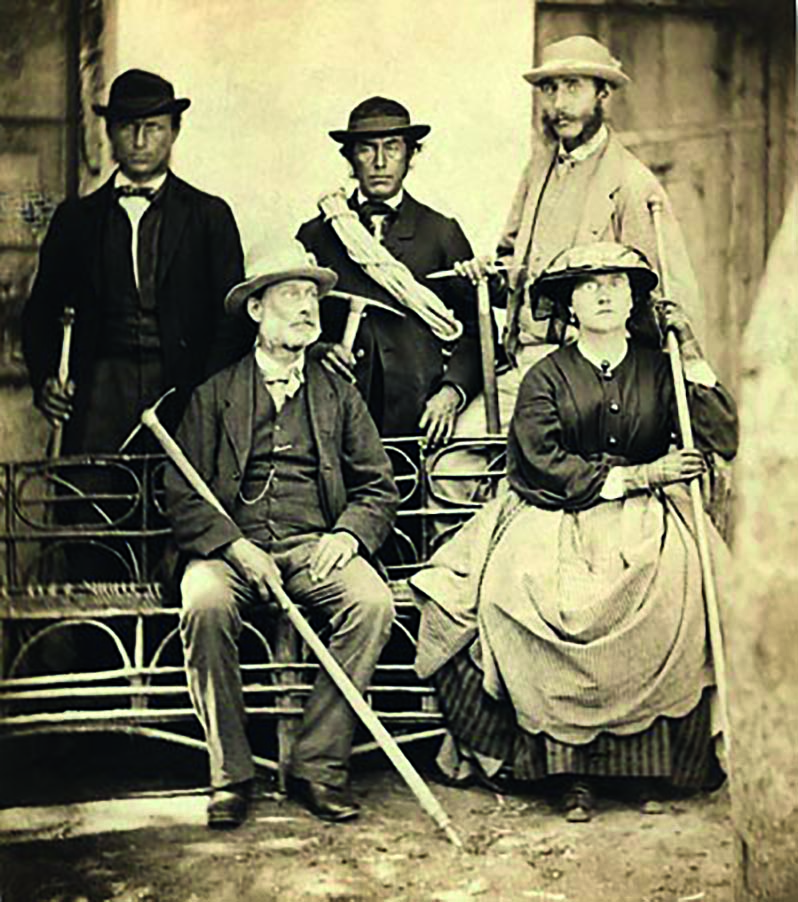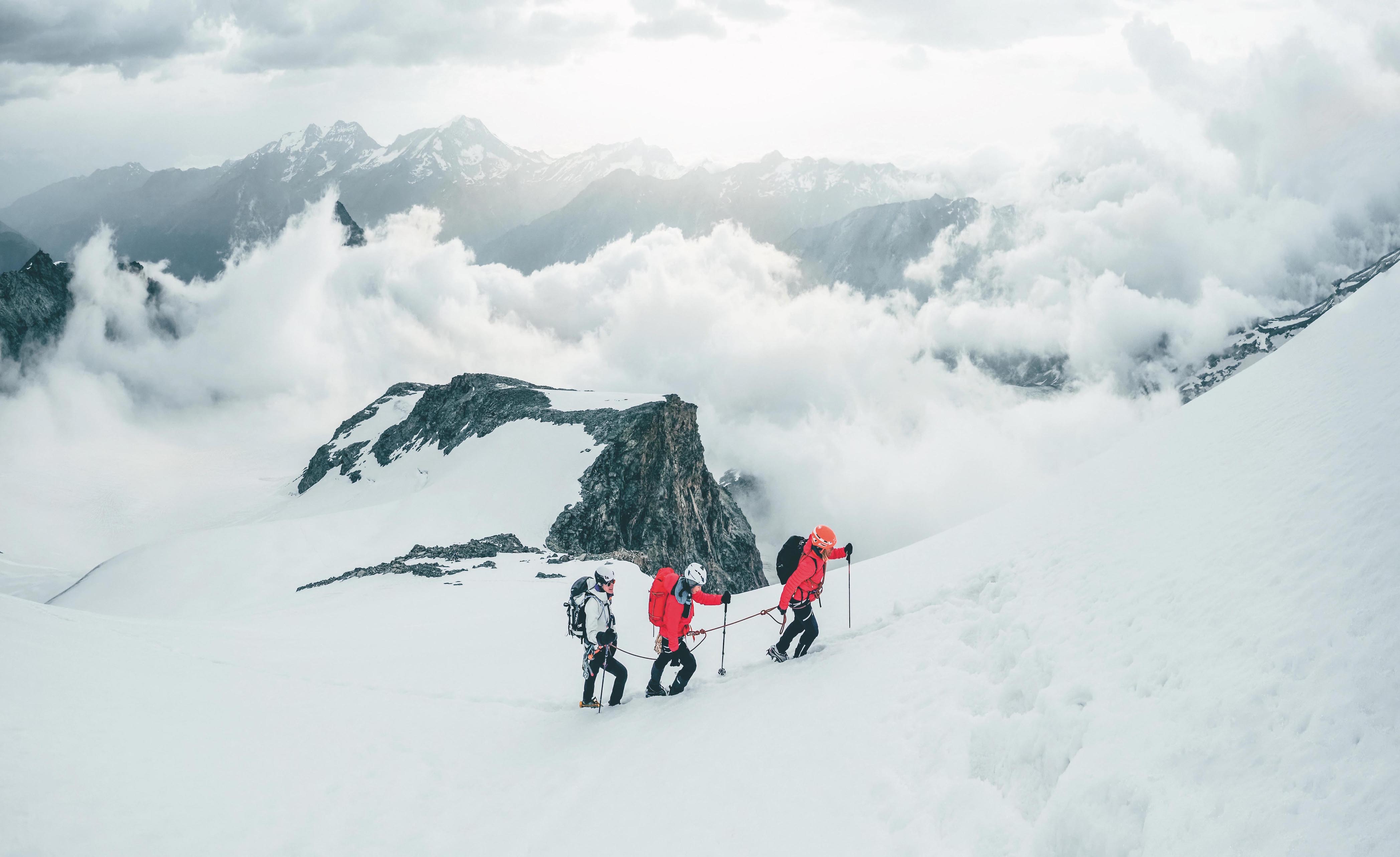In 1871, unsung alpinist Lucy Walker became the first woman to summit the Matterhorn. Now, writes Hanna Lindon, she’s finally getting the recognition she deserves.
Just six years after Edward Whymper’s famous first summit of the Matterhorn, Lucy Walker – a model Victorian hostess from Liverpool with a penchant for croquet, sponge cake and champagne – became the first woman to follow in his footsteps. Wearing hobnail boots and a long flannel skirt (probably scandalously hitched up to tackle the trickier sections), she made the ascent from Zermatt with her father in tow.
Unlike Whymper, Lucy didn’t go on to pen a book about her experiences. In fact, despite going on to summit 28 4000m peaks over a 21-year climbing career, she seems never to have written a word about her achievements as a mountaineer.
That record-breaking ascent of the Matterhorn in 1871 was met with a mixture of derision, incredulity and indifference by the press. “Mountain-climbing is no woman’s work,” was a representative opinion from the Nuneaton Observer.
Mountaineering marvel
She might have scandalised Victorian society, but 150 years later Lucy is finally getting the recognition she deserves.
Earlier this year, Switzerland Tourism, the Swiss Alpine Club, Swiss Mountain Guide Association and Mammut teamed up
to launch the 100% Women Peak Challenge. The aim was to celebrate the anniversary of Lucy’s Matterhorn ascent by encouraging all-female teams to climb Switzerland’s highest mountains. From 8 March to 8 October, more than 400 female mountaineers took part in the challenge, between them summiting all of Switzerland’s 48 4000m+ peaks.

Lucy Walker (right, seated) with her father and others. Photo: Alpine Club
Everything about these modern ascents – from the clothes participants wore and the training they undertook to the proud summit selfies – would have been inconceivable to a woman of Lucy’s time.
Lucy was born in British North America (today’s Canada) in 1836 and later moved to Liverpool, where she soon settled into a conventional life as a society hostess. According to Simon Thompson, author of Unjustifiable Risk?: The Story of British Climbing, she was “inclined to plumpness” and best known for her love of croquet and champagne. It wasn’t until 1858, when a doctor advised her to take up walking as a rheumatism cure, that she began a pioneering alpine climbing career.
Lucy’s achievements include first female ascents on 16 summits, most notably the Eiger, Monte Rosa, the Strahlhorn and the Grand Combin. She was also the first mountaineer of either sex to summit the Balmhorn and one of the first presidents of the Ladies’ Alpine Club (the then-all-male Alpine Club wouldn’t admit her, despite Edward Whymper protesting that “no candidate for election in the Alpine Club… ever submitted a list of qualifications at all approaching the list of Miss Walker”).
Challenging conventions
As one of the first and most committed female alpinists, the barriers Lucy had to overcome were significant. For a start, serious physical training was out of the question. Historian Clare Roche says that “most Victorian doctors advised gentlewomen to refrain from any strenuous exercise”.
There’s no contemporary record of Lucy climbing any British mountains. Claire-Elaine Engel writes in The Alpine Journal: “she indulged in no outdoor recreations but croquet.” She adds that Lucy “was not an athlete, and her greatest asset, when climbing, was her unflinching will power.”
Then there were the conventions surrounding dress. “When climbing, she never dreamt of dressing like a man,” writes Engel. “She used to wear a white printed dress, which had to be given some decent shape when coming back to the hotel after a strenuous climb; rather a thankless task after a rock climb or a long walk down the last moraine.”
Other contemporary accounts suggest that female mountaineers like Lucy would have stashed their petticoats behind a handy rock before heading off on a climb and tied their skirts up to a practical length. “Some ladies dispense with skirts altogether, and lay them aside with the other impedimenta when climbing really begins,” says a 1890 article in The Queen. “But this requires some little courage, and by carefully arranging the length of the skirt, it may be worn without inconvenience.”
Still, Félicitié Carrel, the first woman to attempt an ascent of the Matterhorn, had to beat a hasty retreat after high winds blew up her billowing petticoats and made it too dangerous to continue.
Even setting aside costume complications, female mountaineers still faced scandalising the conventional by hobnobbing with male members of their team. Women weren’t permitted to socialise unchaperoned with men outside their family, which is probably why Lucy’s father – and later her brother – always joined her expeditions.
There were some dictates of convention that had to be simply ignored. With no cable cars to rely on, Lucy would have faced longer ascents than modern alpinists and would probably have slept alongside male team members in high mountain barns and refuges.

An all-female team climbs Switzerland’s Allalinhorn this year as part of the 100% Women Peak Challenge. Photo: Julia Wunsch
Historian E. de Laveleye wrote about meeting her at the Theodule in 1862. “We were extremely surprised when, creeping into this dark den, we saw a young woman endeavouring to dry her garments, soaked with water and crisp with frost, in front of a wretched fire,” he says. “The guides told us she was a young English lady who travelled by herself. She was coming from the top of Mont Blanc and was going to that of Monte Rosa; indeed, she climbed it a few days later. Her name was Miss Walker.
“A moment later, we saw her going away. She had two guides. One was going in front of her, the other behind and a thick rope tied round her slender waist bound her to both hardy mountain natives. She was walking quickly, though floundering in the snow, and she was very soon out of sight behind a thick mist and sheets of drizzle driven by the blizzard.
It was about 11 in the morning.”
Three cheers
Some were scandalised by Lucy’s convention-cracking achievements. “Miss Walker’s wonderful feats in the mountains did not pass without a certain amount of criticism, which her keen sense of humour made her appreciate as much as anyone,” wrote her friend and fellow climber Frederick Gardiner in a 1917 obituary.
In some quarters, though, Lucy was seen as an unlikely heroine. After that first intrepid Matterhorn ascent, satirical magazine Punch published a poem in her honour:
No glacier can baffle, no precipice balk her,
No peak rise above her, however sublime,
Give three times three cheers for intrepid Miss Walker,
I say, my boys, doesn’t she know how to climb!
Inspired by Lucy’s feats – and the successes of other early alpine mountaineers such as New Yorker Meta Brevoort,
who very nearly beat Lucy to the Matterhorn’s summit – other women began testing their mettle on the slopes. Katherine Richardson, Margaret Jackson and Emily Hornby all began climbing within a few years of the first female Matterhorn ascent.
Even Queen Victoria got in on the action. The Monmouthshire Beacon describes her ascending Lochnagar, “her first hill climb”, in 1848 and then Beinn a’Bhuird and ‘Ben Muich Dhui’ a few years later. In 1890 The Queen reported that “every year more ladies are taking to climbing”. And, by 1911, female mountaineers had become accepted enough for The Sketch to publish a spread on the top 15 women climbers.

Members of the women’s climbing club, the Pinnacle Club, at the Lucy Walker memorial in Zermatt. Photo: Jessie Leong
“There is no sphere of sport, in its more serious and perilous aspects, in which women have more distinguished themselves than in mountaineering,” wrote the author. “Woman, in fact, seems to have an aptitude for climbing.”
A key milestone for women mountaineers was the foundation of the Ladies’ Alpine Club in 1907. The club was hugely popular, with at least 250 people attending the annual dinners, and Lucy Walker was one of the first presidents.
Even so, it was viewed with aversion by many members of the all-male Alpine Club. “In days gone by many A.C’s refused to speak to us,” said alpinist Ellen Pigeon. It would take nearly seven more decades before the Alpine Club agreed to admit women – and then after some serious in-fighting.
Gender equality is still an issue in the mountaineering world a century after Lucy’s death. Just 2% of International Federation of Mountain Guides Association members – and 30% of British Mountaineering Council (BMC) members – are women.
But we’re lucky enough to live in an age where many of the impediments faced by Lucy Walker and her fellow female alpinists no longer exist. Some of the credit for that should go to a lively Liverpudlian hostess who quietly defied the bounds of convention and forged a path for future woman mountaineers to follow.
Since March 8 this year, the 100% Women Peak Challenge has seen more than 400 female mountaineers climb all of Switzerland’s 4000m peaks – in teams made up entirely of women. Find out more about it here.








